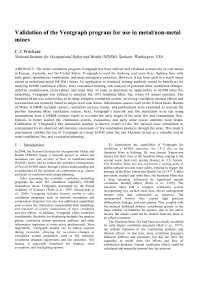Mining Publication: Validation of the Ventgraph Program for Use in Metal/Non-metal Mines
Original creation date: June 2010
The mine ventilation program Ventgraph has been utilized and validated extensively in coal mines in Europe, Australia, and the United States. Ventgraph is used for studying coal mine fires, fighting fires with inert gases, spontaneous combustion, and mine emergency exercises. However, it has been used to a much lesser extent in metal/non-metal (M/NM) mines. Its application to hardrock mining methods would be beneficial for studying M/NM ventilation effects, mine evacuation training, risk analysis of potential mine ventilation changes, airborne contaminants, recirculation, and mine fires. In order to determine its applicability to M/NM mine fire modelling, Ventgraph was utilized to simulate the 1972 Sunshine Mine fire, where 91 miners perished. The Sunshine Mine was selected due to its deep, complex ventilation system, involving ventilation thermal effects and recirculation not normally found in single-level coal mines. Information sources such as the United States Bureau of Mines (USBM) accident reports, ventilation surveys, books, and publications were examined to recreate the pre-fire Sunshine Mine ventilation system. Next, Ventgraph’s network and fire simulation were run using assumptions from a USBM contract report to re-create the early stages of the mine fire and contaminant flow. Options to better control the ventilation system, evacuation, and early mine rescue attempts were tested. Calibration of Ventgraph’s fire simulation module to known events of the fire showed close correlation to contaminant levels observed and real-time movement of fire combustion products through the mine. This study’s conclusions validate the use of Ventgraph in a deep M/NM mine fire and illustrate its use as a valuable tool in mine ventilation, fire, and evacuation planning.
Authors: CJ Pritchard
Conference Paper - June 2010
NIOSHTIC2 Number: 20036995
Proceedings of the 13th U.S./North American Mine Ventilation Symposium, Sudbury, Ontario, Canada, June 13-16, 2010. Hardcastle, McKinnon, eds., Sudbury, Ontario, Canada: MIRARCO - Mining Innovation, 2010; :455-462
See Also
- Computational Fluid Dynamics Study on the Ventilation Flow Paths In Longwall Gobs
- The Critical Ventilation Velocity in Tunnel Fires - A Computer Simulation
- Degasification System Selection for U.S. Longwall Mines Using an Expert Classification System
- Emergency Escape and Refuge Alternatives
- Responders to Underground Mine Fires
- SPONCOM - A Computer Program for the Prediction of the Spontaneous Combustion Potential of an Underground Coal Mine
- SponCom - Spontaneous Combustion Assessment Software - 2.0
- Technical Solutions for Enhancements to Mine Safety Using Barricade II Fire Blocking Gel
- Technology News 545 - NIOSH Updates Spontaneous Combustion Assessment Software
- When Do You Take Refuge? Decisionmaking During Mine Emergency Escape
- Page last reviewed: 9/21/2012
- Page last updated: 9/21/2012
- Content source: National Institute for Occupational Safety and Health, Mining Program


 ShareCompartir
ShareCompartir
